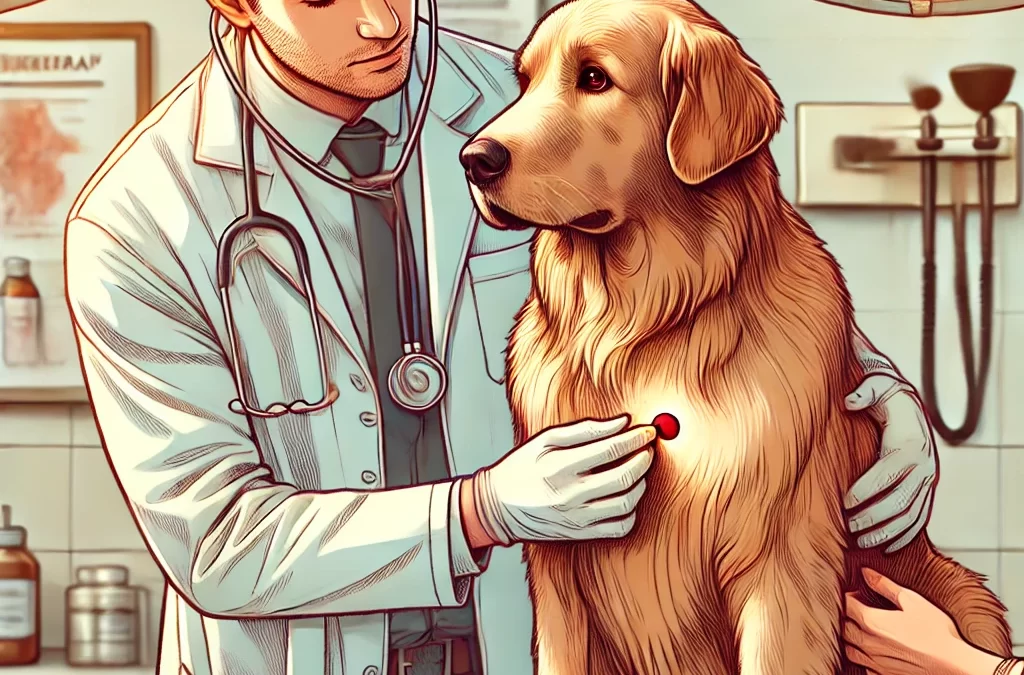
經過 TCMVET | 2025 年 1 月 21 日 | 狗癌症和腫瘤
觀看一隻心愛的狗與晚期癌症作鬥爭是一次激動人心且令人心碎的旅程。雖然治癒可能是不可能的,但有一些方法可以提高他們的舒適度、減輕疼痛並改善他們的剩餘生活品質。本文探討了支持患有晚期癌症的狗的實用、富有同情心甚至替代的方法。
1. 優先考慮疼痛管理
緩解疼痛是晚期癌症照護的基石。傳統的疼痛管理選項包括:
- 處方止痛藥 – NSAID(非類固醇抗發炎藥)和鴉片類藥物(如曲馬多)有助於有效控制疼痛。
- 輔助治療 – 用於治療神經疼痛的加巴噴丁和作為 NMDA 拮抗劑的金剛烷胺與其他止痛藥聯合使用可以提高舒適度。
- CBD 油和草藥 – 許多寵物主人轉向全譜 CBD 油、薑黃和乳香來幫助自然減輕發炎和疼痛。
2.增強活力的營養支持
專為癌症支持而量身定制的飲食可以減緩進展並改善整體健康。考慮:
- 優質蛋白質 – 瘦肉和魚類提供維持肌肉所需的胺基酸。
- 健康脂肪 – 魚油中的 Omega-3 脂肪酸有助於減少發炎並可能減緩腫瘤生長。
- 低碳水化合物、高纖維飲食 – 癌細胞靠糖而茁壯成長,因此減少碳水化合物的攝取可能有助於減緩進展。
- 天然補充品 – 火雞尾和靈芝等藥用蘑菇以及黃耆等中草藥可以提供免疫支持。
3. 舒適性和活動性的整體療法
除了藥物和飲食之外,整體治療還可以提供額外的緩解:
- 針刺 – 有助於減輕疼痛、改善活動能力並促進能量平衡。
- 按摩療法 – 輕柔的按摩可促進血液循環並緩解僵硬。
- 水療 – 溫水療法可緩解關節壓力並促進溫和的運動。
- 能量療癒與靈氣 – 一些寵物主人探索能量療法以放鬆和緩解壓力。
4.創造舒適的環境
調整你的狗的生活空間可以產生巨大的變化:
- 柔軟寢具和矯形支架 – 記憶海綿床可減輕壓瘡和關節疼痛。
- 溫度控制 – 年長、患病的狗很難調節溫度,因此讓它們冬暖夏涼至關重要。
- 最小化壓力 – 安靜、平靜的環境和熟悉的氣味有助於緩解焦慮和疼痛。
5. 管理消化問題和水分
癌症會導致噁心、腹瀉和食慾不振。解決這些症狀有助於改善健康:
- Appetite Stimulants – 米氮平等藥物可以鼓勵進食。
- 自製骨湯 – 對胃溫和,富含營養成分,並且保濕。
- 益生菌和消化酶 – 支持腸道健康並幫助消化。
- 經常補充水分 – 確保充足的水攝取量可防止脫水並支持腎功能。
6. 情感支持與紐帶時刻
對於處於最後階段的狗來說,您的存在是最大的安慰之一。花時間在一起:
- 參加最喜歡的活動 – 短暫的步行、乘車或安靜的擁抱都可以帶來快樂。
- 和你的狗說話 – 你的聲音令人安心和平靜。
- 無所畏懼地在場 – 狗能感知情緒,因此保持平和和充滿愛的能量可以幫助它們感到安全。
7. 知道何時說再見
最困難的決定之一是確定何時安樂死是最富同情心的選擇。考慮:
- HHHHHMM 量表 – 由 Alice Villalobos 博士開發,這項生活品質評估衡量傷害、飢餓、補水、衛生、幸福、流動性以及好日子多於壞日子。
- 獸醫臨終關懷和家庭安樂死 – 許多獸醫提供上門服務,以便在熟悉的環境中和平過渡。
- 聆聽你的狗的聲音 – 行為舉止的變化、藥物治療後持續疼痛或完全喪失食慾都可能表示是時候了。
結論
照顧患有晚期癌症的狗是一次充滿愛、奉獻和同情心的深刻經歷。透過專注於疼痛管理、營養支持、整體治療和情緒健康,寵物父母可以確保他們的狗在餘下的日子裡充滿舒適和尊嚴。無論是選擇安寧療護或最終做出告別的艱難決定,目標都是一樣的:尊重這種紐帶,並為他們提供盡可能最好的生活品質。

經過 TCMVET | 2025 年 1 月 20 日 | 狗癌症和腫瘤
當涉及狗的癌症和腫瘤發展時,大小確實很重要。小型和大型品種具有不同的遺傳傾向、代謝率和免疫反應,所有這些都會導致腫瘤的發展、進展和對治療的反應發生變化。如果您是一位關心您的狗的健康的寵物父母,了解這些差異可以幫助您在預防、早期發現和治療方面做出明智的決定。
1. 遺傳因子:品種特異性腫瘤風險
有些癌症在某些品種中更常見,而狗的體型往往在這種易感性中發揮作用。
- 大型品種:像黃金獵犬、大丹犬和羅威納犬這樣的狗更有可能發育 骨肉瘤(骨癌)、血管肉瘤(血管癌)和淋巴瘤。這些癌症往往具有侵襲性,並且通常會迅速轉移。
- 小品種:貴賓犬、臘腸犬和吉娃娃犬等品種較容易出現 良性腫瘤,如脂肪瘤和乳頭狀瘤,但他們也可以發展 乳腺腫瘤和膀胱癌.
差異不僅在於腫瘤的類型,還在於這些癌症的表現和對治療的反應。
2. 腫瘤生長速度與行為
由於生長速度和細胞代謝的差異,小型犬和大型犬的腫瘤進展有顯著差異。
- 大型犬的生長速度較快:較大的品種在幼犬時期生長迅速,這種快速的細胞分裂可能會導致更高的發育風險 惡性腫瘤 在以後的生活中。他們的腫瘤也往往更具侵襲性。
- 小型犬生長緩慢:雖然小型品種的腫瘤可能發展得更慢,但它們仍然是一個問題。 良性腫瘤 脂肪瘤很常見,但如果長得太大,可能會影響活動能力。此外,小型犬仍可能患有惡性腫瘤,例如 肥大細胞腫瘤,如果不及時治療可能會傳播。
3. 預期壽命和腫瘤發生
大型犬的壽命往往比小型犬短,這會影響腫瘤的發展時間。
- 大型犬的早發性癌症:由於大型品種衰老得更快,因此它們更有可能在較年輕的時候患上癌症——通常是在 6至8歲。這意味著業主應該儘早開始癌症篩檢和預防護理。
- 小型犬的晚發腫瘤:小型品種可能不會表現出癌症跡象,直到它們 高年級(10歲以上),這意味著長期監測至關重要。
了解這些時間表可以幫助寵物主人在正確的時間安排獸醫檢查,以便及早發現潛在的腫瘤。
4. 診斷與治療挑戰
在診斷和治療腫瘤時,腫瘤的大小在檢測和執行手術的能力方面都發揮著重要作用。
- 手術注意事項:大型犬由於體重較大,可以更好地耐受某些手術,但切除承重骨中的腫瘤(如骨肉瘤)可能具有挑戰性。另一方面,小型犬可能會面臨麻醉風險,尤其是當它們很小的時候。
- 化療和藥物治療的差異:化療劑量取決於體重,較大的狗通常需要 更高的藥物劑量,增加治療費用。小型犬儘管需要較低的劑量,但由於其脆弱的系統,可能會經歷更強烈的副作用。
5. 預防和早期發現策略
無論規模大小,早期發現至關重要。狗主人可以這樣做:
- 常規獸醫檢查:定期檢查有助於在腫瘤變得太大之前發現它們。
- 在家進行身體檢查:每週用手撫摸狗狗的身體可以幫助發現異常腫塊。
- 特定品種癌症篩檢:大型犬種應儘早進行 X 光檢查和超音波檢查,而小型犬種則可能受益於皮膚和膀胱檢查。
- 飲食和生活方式調整:均衡飲食、規律運動和體重管理有助於支持整體健康並可能降低癌症風險。
最後的想法
雖然腫瘤會影響小型犬和大型犬,但它們在遺傳學、腫瘤行為和治療選擇方面的差異意味著寵物主人需要量身定制的護理策略。大型犬在年輕時更容易罹患侵襲性癌症,而小型犬在以後的生活中可能會出現生長緩慢的腫瘤。透過了解這些差異並優先考慮早期檢測,狗主人可以改善寵物的生活質量,並有可能延長它們在一起的時間。

經過 TCMVET | 2025 年 1 月 20 日 | 狗癌症和腫瘤
想像一下:在一次充滿樂趣的散步後,您剛剛為您的狗做了一次應得的腹部按摩。突然,你的指尖擦到了一個你以前從未註意到的小腫塊。提示懸疑的音樂-外星入侵者(讀作:惡性腫瘤)建立了營地,還是只是一個無害的佔屋者(良性生長)在你的狗的皮膚下寒冷?在你拉響警報或聳聳肩之前,讓我們先來了解如何解碼你毛茸茸的朋友體內這些神秘的新房客。
1.《成長犯罪現場調查》:重要的法醫線索
將自己想像成一部高風險犯罪劇中的偵探。你的工作是收集所有證據:
- 質地和流動性:惡性腫瘤通常感覺不規則並且可能附著於周圍組織,而良性腫塊往往更光滑且更容易移動。
- 成長率:這個腫塊是像氣球一樣迅速膨脹,還是在數週或數月內保持相同的大小?更快的生長可能預示著惡性腫瘤。
- 相關症狀:食慾變化、嗜睡、體重減輕或局部疼痛可能是額外的危險信號,需要立即引起注意。
關鍵要點是什麼?不要僅根據腫塊的感覺就急於下結論。但請務必隨時更新您的「偵探筆記本」的觀察。
2. 科學英特爾:診斷測試揭示真相
就像任何優秀的驚悚片一樣,您需要一個合格的合作夥伴來破案。在本集中,他是您值得信賴的獸醫,配備高科技工具和對細節的敏銳洞察力:
- 細針穿刺切片檢查 (FNA):一種快速、微創的測試,可以立即提供細胞線索。將其視為收集腫塊身份的「指紋」。
- 活檢:有時,需要仔細觀察,例如分析嫌疑人的 DNA。活檢可以更深入地了解組織的結構和細胞行為。
- 影像工具:X 光、超音波或 MRI 充當偵探的放大鏡,發現有關生長邊界和潛在擴散的隱藏線索。
3. 腫瘤還是良性生長?理解判決
收集證據並進行測試後,就會有結論。這通常需要及時、有時是積極的治療,其中可能包括手術、化療或放療。良性生長——我們的「無害擅自佔地者」——通常生長緩慢並受到限制,但這並不意味著您可以隨時忽視它們。有些良性腫塊仍然會壓迫重要器官或隨著時間的推移而潰爛,需要切除或定期監測。
4. 制定治療總體規劃
無論診斷結果是無害的佔屋者還是已確診的外星入侵者,制定可靠的遊戲計劃都是不容談判的:
- 手術切除:通常是第一道防線-例如驅逐壞房客。
- 藥物與療法:如果腫瘤是惡性的,化療、標靶治療或免疫治療可以使病情向對您的狗有利的方向傾斜。
- 生活方式調整:從專門的飲食到溫和的日常鍛煉,整體支持可幫助您的狗狗在整個治療過程中感覺最佳。
- 持續監控:將此視為您的周邊巡邏,以確保沒有可疑腫塊返回或出現在其他地方。
5. 慶祝勝利並分享旅程
發現新的腫塊可能會為你心愛的寵物的故事帶來可怕的轉折。但請記住:並非每一次的顛簸都是厄運和悲觀的情況。憑藉警惕和積極主動的態度,您可以將“外星人與佔屋者”之謎變成您的狗一生冒險中易於處理的次要情節。與您的獸醫分享最新情況,慶祝小小的勝利(穩定的腫塊、成功的手術、良好的能量水平),並珍惜沿途的每一次搖尾巴。
因為歸根結底,每個值得講述的偵探故事都以希望結束——也許還可以為世界上最好的伙伴——你的狗——帶來一些額外的享受。

經過 TCMVET | 2025 年 1 月 18 日 | 狗癌症和腫瘤
狗的癌症是一項艱鉅的挑戰,通常診斷得太晚,無法有效幹預。活檢和成像等傳統診斷工具有其局限性——它們可能是侵入性的、成本高昂或無法在早期檢測腫瘤。輸入腫瘤生物標記:在血液、尿液或組織中發現的分子特徵,為犬類腫瘤學提供了一種改變遊戲規則的方法。隨著獸醫學的進步與人類腫瘤學的突破並行,開發可靠、非侵入性生物標記以實現早期檢測、即時監測和個人化治療策略的競賽正在展開。
1. 什麼是腫瘤生物標記物,為何它們重要?
腫瘤生物標記是可測量的生物物質,顯示癌症的存在、進展或對治療的反應。這些可以是:
- 蛋白質和酵素:特定蛋白質(例如 C 反應蛋白 (CRP) 或胸苷激酶 1 (TK1))水平升高可能表示存在惡性腫瘤。
- 循環腫瘤 DNA (ctDNA):在血液中發現的腫瘤來源的 DNA 片段提供了對基因突變和腫瘤負荷的深入了解。
- 外泌體和 MicroRNA (miRNA):微小的細胞外囊泡和非編碼 RNA 正在成為癌症檢測和預後的有前途的工具。
在癌症出現臨床症狀之前檢測到癌症的能力可以大大改善狗的治療結果和生活品質。
2. 生物標記革命:從概念到臨床應用
2.1. 早期檢測:最終的遊戲規則改變者
早期癌症通常無症狀,這使得常規篩檢成為一項挑戰。生物標記可以透過在症狀出現之前很久識別惡性腫瘤來填補這一空白。
- 犬類特異性 CRP 和 TK1:水平升高與淋巴瘤、血管肉瘤和肥大細胞瘤有關。
- 血清微小RNA:某些 miRNA 譜與骨肉瘤和前列腺腫瘤密切相關,為常規血液檢查檢測高風險病例鋪平了道路。
2.2. 預後見解:精確預測結果
並非所有腫瘤的行為方式都相同。生物標記幫助獸醫區分侵襲性癌症和緩慢生長的腫瘤,從而製定量身定制的治療策略。
- Ki-67 和 PCNA(增殖標記):高表達量表示腫瘤生長快速且預後較差。
- LDH(乳酸脫氫酶):LDH 水平升高通常表示血管肉瘤發生轉移,從而指導治療強度。
2.3. 治療監測:即時治療調整
生物標記可以對腫瘤反應進行非侵入性跟踪,使獸醫能夠動態調整治療方法。
- 循環腫瘤 DNA (ctDNA):監測 ctDNA 水平可以顯示狗對化療或放療的反應程度。
- 外泌體分析:治療後外泌體貨物成分的變化提供了有關殘留疾病和復發風險的線索。
3. 尖端科技塑造犬腫瘤學的未來
3.1. 人工智慧 (AI) 遇上生物標記
人工智慧驅動的診斷工具現在正在接受培訓,可以分析生物標記模式,提供近乎即時、高度準確的評估。想像一下人工智慧驅動的血液檢查可以在臨床症狀出現之前預測癌症風險!
3.2. 液體切片:侵入性診斷的終結?
液體切片檢查可檢測 ctDNA 和外泌體標記物,可望徹底改變癌症診斷方法。與傳統的活檢不同,它提供了腫瘤演變的微創即時快照。
3.3. 狗的個人化藥物
隨著生物標記研究的進展,獸醫可能很快就能做出生物標記驅動的決策,根據狗獨特的腫瘤特徵選擇最佳的化療、免疫療法或標靶治療。
4. 挑戰和道德考慮
儘管有希望,基於生物標記的診斷仍面臨障礙:
- 標準化問題:生物標記水平可能因品種、年齡和併發疾病而異。
- 成本與可近性:先進的生物標記測試仍然昂貴且尚未廣泛應用。
- 誤報和誤報: 100% 沒有任何生物標記測試是萬無一失的-需要進一步完善以確保可靠性。
5. 結論:犬癌症治療新時代的黎明
腫瘤生物標記不再只是理論工具——它們正迅速成為犬癌症診斷、預後和治療不可或缺的一部分。透過擁抱這場分子革命,獸醫學正在邁向一個更早發現癌症、更精確治療並以前所未有的準確度監測癌症的未來。
隨著技術的發展,透過簡單的血液測試來篩檢多種犬類癌症的夢想可能很快就會成為現實,為狗及其主人帶來更多的時間和更好的生活品質的寶貴禮物。

經過 TCMVET | 2025 年 1 月 18 日 | 狗癌症和腫瘤
隨著尖端技術和前瞻性研究的融合,獸醫腫瘤學領域正在見證一場巨大的轉變,改變了我們治療犬腦腫瘤的方法。雖然傳統的診斷方法和傳統的治療方式長期以來一直指導著從業者,但創新的新時代有望重新定義臨床結果並增強我們對這些複雜病症的理解。下面,我們將探討最先進的診斷工具、人工智慧以及立體定位放射外科 (SRS) 日益增長的影響力如何突破犬類神經腫瘤學的界限。
- 從症狀到懷疑:不斷變化的診斷格局
1.1.認識不尋常
從歷史上看,檢測犬類腦腫瘤取決於識別微妙的神經系統症狀,例如持續的頭部傾斜、共濟失調以及行為或食慾的變化。雖然這些危險訊號仍然至關重要,但先進的影像和數據分析提供了更細緻的視角。由於高解析度成像和精細的診斷演算法,醫生現在能夠更好地區分發炎、感染和腫瘤。
1.2.先進成像的興起
• 高場MRI:高場MRI 被認為是可視化顱內病變的黃金標準,可提供軟組織和病變邊界的詳細影像。最新的 MRI 序列,包括功能性 MRI (fMRI) 和擴散張量成像 (DTI),可以更深入地研究腫瘤生物學,在宏觀異常出現之前揭示微觀結構的變化。
• 磁振造影波譜(MRS):MRS 透過評估腫瘤內的代謝變化提供分子層面的見解。例如,膽鹼和乳酸峰值升高可以作為惡性腫瘤或侵襲性生長的早期預警信號。
• 人工智慧輔助影像分析:由人工智慧驅動的創新演算法使得以驚人的速度和準確性檢測和量化腫瘤生長成為可能。這些工具可以整合臨床數據、影像標記和組織病理學結果來預測腫瘤可能的進展或對治療的反應。
1.3.活檢及其他
儘管影像技術已經有了很大發展,但組織病理學確認仍然是明確診斷的支柱。立體定位活檢技術可最大限度地減少侵入性、降低併發症並加速復原。在不久的將來,液體活檢——分析血液中的循環腫瘤細胞或腫瘤DNA——可以進一步減少對侵入性手術的需求,為即時腫瘤監測和動態治療調整鋪平道路。
- 量子飛躍:立體定位放射外科
2.1.打破傳統放射治療的模式
幾十年來,體外放射治療是治療無法手術或具有手術挑戰性的犬腦腫瘤的事實上的方法。雖然在某些情況下有效,但它通常需要幾週的多次會議。立體定位放射外科 (SRS) 是一種精確驅動的技術,可在一次或幾次療程中向腫瘤提供集中的放射劑量,最大限度地減少對周圍健康組織的損害。
2.2. SRS 的標誌
• 精確定位:先進的影像和電腦化的治療計畫確保放射束僅瞄準腫瘤,而不會傷害周圍的結構。
• 減少治療次數:許多犬隻立體定位放射手術方案需要減少就診次數,進而減輕寵物及其主人的壓力。
• 快速緩解症狀:與傳統分割放射治療相比,高劑量放射通常可以更快地縮小腫瘤,從而更快地控制症狀。
• 副作用最小:集中的方法可以減少與放射線相關的併發症,例如皮膚刺激或脫髮。
2.3.尖端設備
獸醫醫院越來越多地採用曾經用於人類醫學的系統,例如伽瑪刀和射波刀裝置。這些設備依靠數百個會聚輻射束或能夠從多個角度提供高劑量輻射的機械手臂,確保無與倫比的精度和控制。
2.4.將 SRS 與其他方式結合
立體定位放射外科不再是一個孤立的手術。許多專家提倡採用多模式方法,結合:
• 針對微小疾病和遠端轉移的化療或標靶治療。
• 免疫療法可增強人體檢測和消滅癌細胞的先天能力。
• 營養支持和康復,以改善整體健康、加速恢復並維持肌肉質量。
- 未來之路:挑戰與機遇
3.1.財務和後勤考慮
高端技術(例如專用放射治療機)需要大量的財務支出。因此,並非所有獸醫中心都能提供 SRS,限制了可近性。然而,隨著技術的成熟和更多診所採用先進設備,成本可能會下降。
3.2.突破研究界限
獸醫學領域的長期結果數據和大規模臨床試驗仍然相對稀缺。透過培養獸醫、腫瘤學家、放射科醫生和醫學物理學家之間的多學科合作,該領域可以收集關於狗 SRS 的安全性、有效性和最佳方案的有力證據。
3.3.個人化醫療及其他
分子分析、基因檢測和數位健康記錄正在融合,為獸醫護理創造更個人化的醫療環境。未來的創新可能會結合即時生物標記跟踪,以動態調整治療策略——有可能以我們今天難以想像的方式徹底改變犬類神經腫瘤學。
- 結論
狗腦腫瘤的診斷和治療從未如此複雜,也從未如此充滿希望。高精度成像、人工智慧驅動的分析和立體定位放射外科的融合正在重新定義獸醫腫瘤學的可能性。雖然仍然存在重大挑戰——從確保廣泛可及性到收集大規模證據——但集體的勢頭為患有腦腫瘤的犬類患者帶來了更光明的未來。
透過擁抱這些新領域,我們不僅提高了犬類神經腫瘤學的護理標準,而且提高了獸醫學本身更廣泛的使命:最大限度地提高我們心愛的同伴的健康、舒適和壽命。隨著立體定位放射手術和其他突破性療法獲得關注,曾經看似遙遠的可能性正在迅速成為新常態——為患有腦腫瘤的狗提供真正非凡的第二次生命機會。

經過 TCMVET | 2025 年 1 月 17 日 | 狗癌症和腫瘤
發現你的狗患有腫瘤可能會令人痛苦,寵物主人問的第一個問題是“我的狗還能活多久?”答案取決於多種因素,包括腫瘤的類型、位置、階段、治療選擇和狗的整體健康狀況。了解這些要素可以幫助您做出明智的決定,並為您的毛茸茸的伴侶提供最好的照顧。
腫瘤類型及其對預期壽命的影響
並非所有腫瘤都會危及生命。有些是良性的,可能不會影響你的狗的壽命,而有些則是惡性的,可以積極傳播。
1.良性腫瘤
良性腫瘤,例如脂肪瘤和皮脂腺瘤,通常不會影響狗的壽命,除非它們幹擾運動或器官功能。在許多情況下,狗狗無需治療即可過正常生活,但為了舒適起見,可能會考慮手術切除。
2. 惡性腫瘤(癌性腫瘤)
惡性腫瘤帶來更嚴重的風險,因為它們可以侵入周圍組織並轉移到其他器官。犬常見的惡性腫瘤包括:
- 肥大細胞腫瘤 (MCT): 可能生長緩慢或具有攻擊性。透過早期切除,許多狗可以繼續存活數年,但晚期病例可能會顯著縮短壽命。
- 骨肉瘤(骨癌): 高度侵襲性,通常需要截肢和化療。如果不進行治療,存活時間通常為 3-6 個月,但經過治療,有些狗可以存活 1-2 年甚至更長。
- 淋巴瘤: 最常見的犬類癌症之一。透過化療,緩解可以將狗的生命延長1-2年,但如果不治療,存活時間通常為1-2個月。
- 血管肉瘤: 一種快速擴散的癌症,影響脾臟、心臟或肝臟。預後很差,即使接受治療,存活期也只有幾週到幾個月。
- 乳房腫瘤: 如果及早發現並透過手術切除,許多狗會康復得很好。然而,已經擴散的惡性病例會顯著降低預期壽命。
影響狗狗生存時間的關鍵因素
有幾個變數會影響患有腫瘤的狗的壽命:
1. 早期發現與診斷
越早發現腫瘤,有效治療的機會越大。定期獸醫檢查和監測腫塊、體重減輕或行為變化可以導致早期幹預,從而大大延長壽命。
2. 腫瘤類型、部位和分期
腫瘤的大小、位置和擴散程度決定了它對狗狗健康的影響程度。影響重要器官或神經系統的腫瘤往往更危險,而皮膚腫瘤或四肢腫瘤可能更容易治療。
3. 治療選擇與反應
治療顯著影響存活時間。常見選項包括:
- 手術: 可以完全切除良性腫瘤和一些局部癌症,有可能完全康復。
- 化療: 常用於治療淋巴瘤等癌症。雖然它可能無法治愈癌症,但可以延長狗的壽命並提高生活品質。
- 放射治療: 幫助縮小無法手術切除的腫瘤。
- 整體與安寧療護: 自然療法、飲食改變和疼痛管理可以改善晚期狗狗的舒適度和健康狀況。
4. 整體健康狀況和年齡
與患有其他潛在健康問題的年長狗相比,具有強大免疫系統的年輕狗更有可能對治療產生良好反應。維持健康的生活方式、均衡的飲食和運動可以支持更好的結果。
5. 生活品質考慮因素
除了生存時間之外,狗的生活品質也是一個關鍵因素。監測疼痛程度、食慾、活動能力和精力水平可以幫助確定最佳的行動方案。在某些情況下,如果狗狗正在遭受痛苦,人道安樂死可能是最仁慈的選擇。
如何支持患有腫瘤的狗
1. 與獸醫密切合作
定期檢查、診斷測試和量身定制的治療計劃可以幫助最大限度地延長狗的壽命和舒適度。
2.提供營養豐富的飲食
富含瘦蛋白、omega-3 脂肪酸和抗氧化劑的抗癌飲食可以支持免疫系統和整體健康。
3. 控制疼痛和不適
疼痛管理,無論是透過藥物、針灸或草藥補充劑,都可以大大改善狗的健康。
4. 監控行為變化
注意到嗜睡、食慾不振或呼吸困難等跡象可以幫助您及時調整照護策略。
5.考慮替代療法
一些寵物主人在傳統療法的基礎上探索中藥、CBD油或其他整體療法來支持他們的狗的健康。
最後的想法
狗的腫瘤診斷並不一定意味著末日即將來臨。透過適當的照顧、治療和生活方式調整,許多狗可以快樂地生活數月甚至數年。關鍵是早期發現、適當治療和維持高品質的生活。每隻狗都是不同的,透過與獸醫密切合作,您可以做出最佳決定,以確保您的寵物的剩餘時間盡可能舒適和充實。
您想了解更多有關特定腫瘤類型、治療方案或整體護理方法的資訊嗎?






